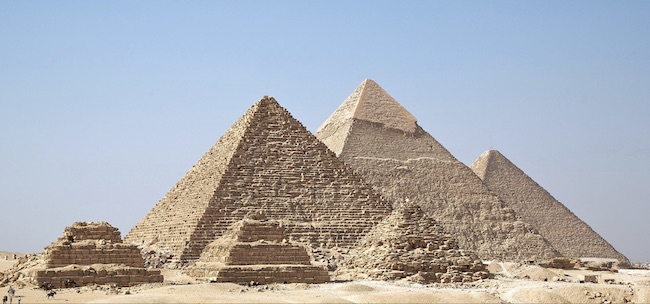Science behind how the Pyramids were builtAlthough there are well over 100 pyramids throughout Egypt and Sudan the Giza pyramid complex (also called the Giza necropolis) in Egypt is the most well known and home to the Great Pyramid, the Pyramid of Khafre, and the Pyramid of Menkaure. All were built during the Fourth Dynasty of the Old Kingdom of ancient Egypt -- characterized as a "golden age" of the Old Kingdom of Egypt -- between c. 2600 – c. 2500 BC. They were popularised in Hellenistic times, when the Great Pyramid was listed by Antipater of Sidon as one of the Seven Wonders of the World. It is by far the oldest of the Ancient Wonders and the only one still in existence. To this day one of the biggest mysteries about the Egyptian pyramids is what the construction techniques used to erect them was. The main unknowns of the construction of the pyramids primarily center on the question of how the blocks were moved up the superstructure. There is currently no known accurate historical or archaeological evidence that definitively resolves the question. Therefore, most discussion on construction methods involves functional possibilities that are supported by limited historical and archaeological evidence. The first historical accounts of the construction of these monuments came centuries after the era of pyramid construction, by Herodotus in the 5th century BC and Diodorus Siculus in the 1st century BC. Herodotus's account claims that the Egyptians used a machine (now commonly referred to as the "Herodotus Machine"). The contraption supposedly allowed workers to lift heavy building materials. Herodotus is believed to have encountered the device while traveling through Egypt. With limited reference and no true schematics, this machine has stimulated many historians' theories of how the ancient Egyptians were able to create pyramids. Use of RampsMost Egyptologists acknowledge that ramps are the most tenable of the methods to raise the blocks, yet they acknowledge that it is an incomplete method that must be supplemented by another device. Archaeological evidence for the use of ramps has been found at the Great Pyramid of Giza and other pyramids. The method most accepted for assisting ramps is levering. LeveringLevering methods are considered to be the most reasonable solution to complement ramping methods, partially due to Herodotus's description; and partially to the water lifting device-- a lever-enabled irrigation device first depicted in Egypt during the New Kingdom and found along with the Old Kingdom in Mesopotamia. Latest ResearchA study done by Christian Wagner and colleagues at Saarland University in Germany, along with researchers in the Netherlands, Iran and France were inspired by an ancient Egyptian wall painting that showed a huge statue being hauled across the sand on a sledge in about 1800 BC. A worker who appears to be pouring water onto the sand in front of the sledge while others appear to be carrying water to replenish his supply suggested that a combination of water and sand was used to reduce friction. "...the showed that just a small amount of water acts as a lubricant that reduces friction in sand that is being pushed through a tube... too much and friction increased. To test their new theory, Wagner, Fiscina and colleagues measured the resistance experienced by a sledge being dragged through different types of sand. "...In the case of one type of sand tested, the coefficient of dynamic friction nearly halved when the water content of the sand reached about 5%. This sand is similar to that found in Egypt, suggesting that wetting the sand would have been a boon to ancient monument builders. The results also indicate that the pyramid builders had luck on their side. Egyptian sand is “polydispersive”, which means that it contains grains of many different sizes. When Wagner and colleagues used sand in which most grains were of a certain size, the drop in friction was much less than that seen in the Egyptian-like sand. ..." source physicsworld.com
References and ReadingsHow were the Egyptian pyramids built? Scientists Have an Answer to How the Egyptian Pyramids Were Built How Did Egyptians Build the Pyramids? Ancient Ramp Find Deepens Mystery Joe Rogan: The Secrets & Mysteries Of The Egyptian Pyramids! Did slippery sand help Egyptians build the pyramids? Egyptian 'Goldlocks Sand Formula: Not too Dry...Not too Wet....Just Moist
|
